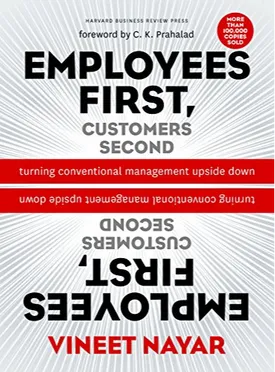Employees First, Customers Second: Turning Conventional Management Upside Down by Vineet Nayar
Employees First, Customers Second: Turning Conventional Management Upside Down by Vineet Nayar is a book which presents a radical shift in managing business as opposed to the traditional practice of placing customers first. Rather than attending to customer needs as always, there is a case made for focusing on the needs of the employees first. The case is built on empirical evidence, best practices, and the actual experience of the author whose own company reversed the traditional management style with success.
The premise of the book does not deny the importance of customers and customer service, rather that employees should be given priority when making management decisions. When employees are given their deserved attention, they are able to attain higher levels of motivation and satisfaction, resulting in better customer service. And when customer service is enhanced, the results are better bottom-line results for the business.
The book examines different aspects of an organization to explore the concept of turning the traditional management upside down. First, the author discusses how an organization can update its core values to ensure that employees are given priority. He explains how the traditional corporate hierarchy must be turned on its head so the organization can be run in an environment of trust, transparency and teamwork. The author also explores ways of creating a healthier and more honest relationship between the organization and its customers.
The author then goes on to discuss how different management practices can be placed into place so that an organization can better incentivize employees. This includes the use of open communication and collaboration, empowering employees by giving them a sense of ownership, and creating shared challenges that can be met together.
The last part of the book is devoted to offering practical advice on how to organize teams and develop leaders so that there is a healthy ecosystem where employees are driven to reach their fullest potential. Each of these recommendations is supported by the example of the author's own successful business, which was transformed by placing customers second and employees first.
The book concludes by taking readers back to the crux of the argument: employee satisfaction should truly be the focus of a successful business. If employees are given the respect they deserve and the ownership they need through healthy communication, it will create positive ripples throughout the organization and result in better customer service and stronger bottom-line results.

